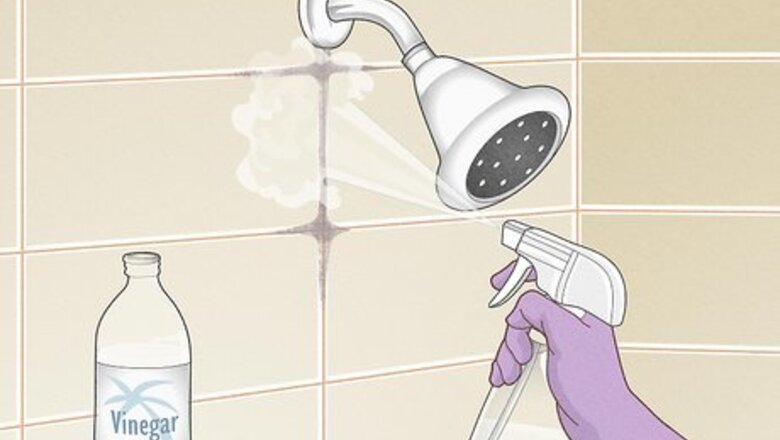
views
Cleaning Mold with Vinegar

Spray undiluted white vinegar onto the mold. Vinegar is acidic enough to kill the mold on contact. Fill a spray bottle with white distilled vinegar just like what you’d use in the kitchen. Apply the undiluted vinegar right onto your shower tiles and grout to get the best coverage. Vinegar has a strong odor, but it will disappear as it dries. If the smell bothers you, try adding a few drops of your favorite essential oil to the spray bottle to keep your bathroom smelling fresh.

Let the vinegar dry for 1 hour. Over this time, the vinegar will penetrate deep into the mold to kill bacteria and make it easier to remove. Once your shower tiles feel dry again, you can move on to the next step.

Rinse the surface with warm water. Wet a cloth with water and wipe the surface. The mold should easily lift up from the grout. Clean off the entire surface until you don’t see any more mold between your tiles. If you have a removable shower head, you can just use that to spray the shower tiles and rinse off the mold.
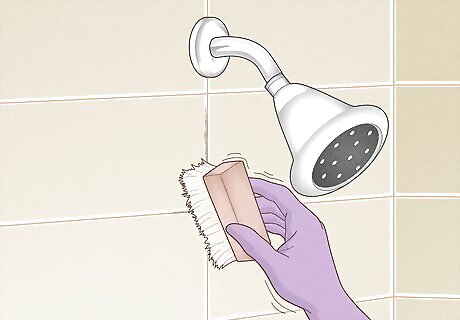
Scrub the grout with a soft-bristled brush for stubborn mold. Use a soft-bristled cleaning brush or an old toothbrush to get into the grout lines. Apply gentle pressure and try to scrape the remaining mold off as best as you can. You may need to spray a little more vinegar or water on the surface to help you break it down.
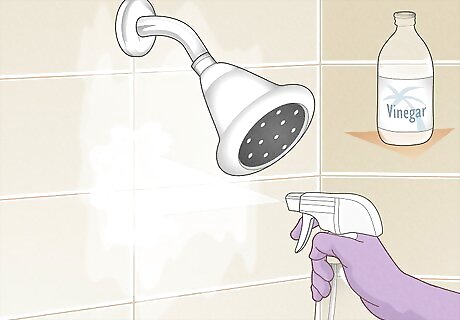
Spray your shower with vinegar again to prevent mold growth. Vinegar also works to keep mold from coming back, so keep a spray bottle in your bathroom. Finish up by applying another even layer of vinegar to your tiles and letting it dry completely. Reapply vinegar after each time you shower as a good preventative measure.
Killing Mold with Baking Soda

Mix baking soda and water into a thin paste. Combine 2 cups (470 ml) of water in a bowl with 1 tablespoon (15 g) of baking soda. Stir the mixture together until the baking soda completely dissolves in the water or until it forms a paste. While this mixture is completely effective against mold on its own, you can add about 20 drops of lemon or orange essential oils to make it smell better and for extra cleaning power. Water and baking soda create a slightly abrasive paste. If you need something a little stronger, try using vinegar instead of water since it will make the baking soda fizz and loosen up stubborn mold.
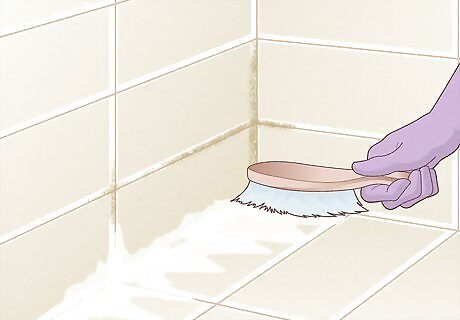
Scrub the paste into the grout with a soft-bristle brush. Dip the bristles of a cleaning brush into the baking soda paste, and then gently scour the grout between your shower tiles. The baking soda will break apart the mold and deodorize your shower so it doesn’t have a musty odor anymore. Keep scrubbing until you remove all of the mold. If you have really small grout lines, an old toothbrush could help you reach mold in those tight spots.
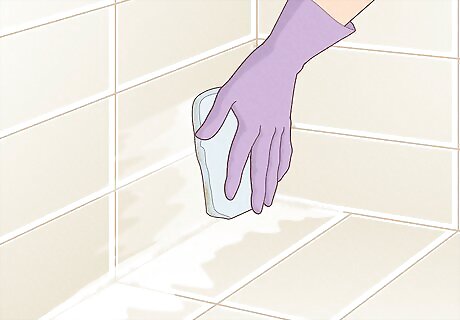
Wipe the paste off of the tile with a wet towel. Dampen a non-abrasive towel with warm water and gently go over all of the tiles you just cleaned. The towel will help clean off any residual paste as well as break apart any mold that’s still left on the surface.
Using Hydrogen Peroxide to Remove Mold

Spot-test hydrogen peroxide to check for discoloration. Since hydrogen peroxide can lighten or discolor materials, take a small amount and rub it onto an inconspicuous spot on your tiles. Wait about a day for the hydrogen peroxide to dry before checking the tile again. If it’s the same color, then you can safely use the peroxide. If the color changes, then use a different cleaning method so you don’t ruin the look of your shower.
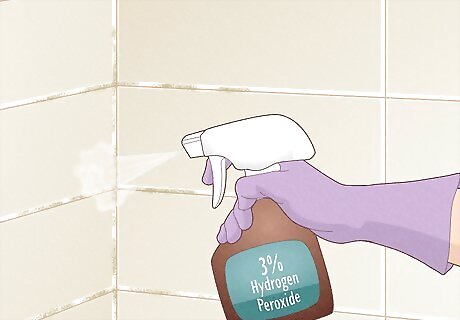
Spray 3% hydrogen peroxide onto the tile. Look for a 3% concentration at your local convenience store since it’s the most effective at killing mold. If it’s not already in a spray bottle, pour the peroxide into one so it’s easier to apply. Evenly coat your grout and tiles with the peroxide. Sunlight makes hydrogen peroxide less potent, so store it in an opaque bottle or a dark cabinet when you aren’t using it.
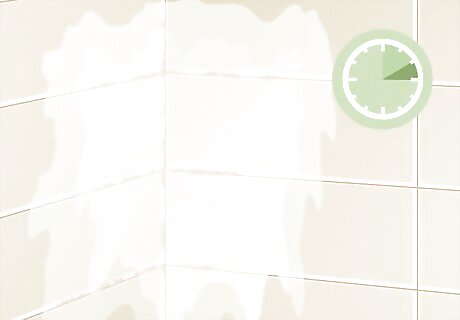
Let the peroxide sit for 10–15 minutes. Since it takes a few minutes for the peroxide to take effect, leave it alone so it can penetrate down to the mold’s roots. After about 10 minutes, the mold should be loose enough to easily remove.
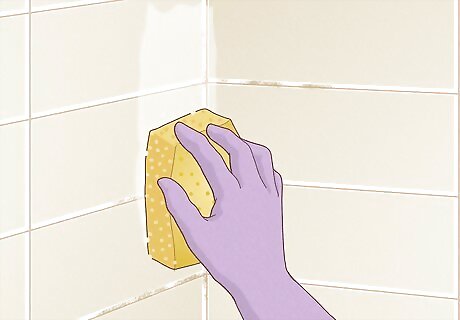
Scrub the grout with a damp rag or sponge. Wet a rag or an abrasive sponge under warm water. Gently go over the grout and apply even pressure to loosen the mold and remove it from your tiles. If you’re having a little trouble removing the mold, try sprinkling a little baking soda onto your rag and wiping your grout again. Combined with the hydrogen peroxide, it may work a little better.
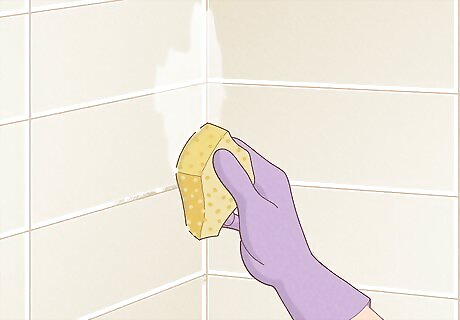
Wipe the tiles with a damp sponge to remove any mold spores. Use a different sponge or rag than the one you just used to clean the mold. Wet it under warm water and go over all of your tiles one last time. That way, any spores that are still left on the surface won’t grow back in your shower.
Trying Essential Oils to Clean Mold

Mix tea tree or citrus seed oil in a spray bottle with water. Both tea tree oil and citrus seed oil, such as lemon or grapefruit, work really well to clean mold. Combine 2 teaspoons (9.9 ml) of your essential oil with 2 cups (470 ml) of water in a glass spray bottle. Shake up the bottle to ensure the solution is thoroughly mixed. You can buy essential oils online or from your local pharmacy. Tea tree oil has a strong odor, while citrus seed extracts do not. Essential oils can cause irritation if they touch your skin, so always dilute before using.
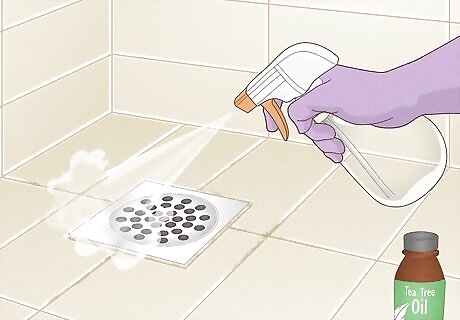
Spray the solution directly onto the mold. Use your spray bottle to apply a generous layer of your cleaning solution to the shower grout. Make sure you saturate the mold completely so the solution is the most effective. Essential oils may be harmful to pets if they ingest or inhale them, so keep any animals away while you’re cleaning.

Let the solution dry completely. As the oils sit on the mold, they’ll kill the harmful bacteria and spores down to the roots. Wait about an hour for the solution to dry completely.

Wipe away the excess mold with a rag. While you don’t have to rinse the solution off, wiping the surface one last time can help remove any noticeable mold patches. Get a rag damp and wring it out before gently wiping your grout. Try to get rid of as much mold as you can. You can always spray your essential oil solution back onto your grout and let it dry again.
Taking Safety Precautions
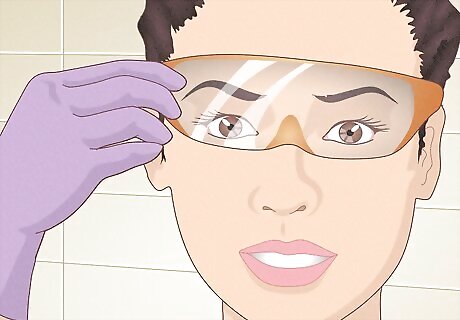
Wear gloves and goggles. Even though most mold that grows in your shower isn’t toxic, it can still cause irritation or allergic reactions if you come into contact with it. Put on a pair of rubber gloves a well as a pair of safety goggles that completely cover your eyes. Avoid touching any mold or mildew with your bare hands since it contains bacteria that could cause infections.

Put on a mask to protect yourself. If you have a mask or respirator, wear it while cleaning the grout so you don't inhale any mold spores. Symptoms of a mold allergy include sneezing, stuffy or runny nose, itchy eyes or throat, and shortness of breath. If you continue having symptoms after being exposed to mold, see a doctor.

Open windows or turn on a fan to ventilate your bathroom. Mold spores are airborne, so they’re probably floating around your bathroom while you clean it. Crack the window in your bathroom if you have one so you can let in some fresh air. Otherwise, you can run the ventilation fan to clear out the spores. If there’s a lot of moisture in the air, run a dehumidifier as well to help dry out your bathroom.
















Comments
0 comment